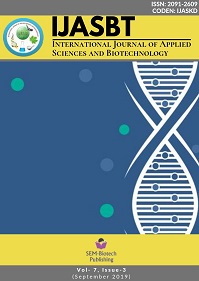Ethno-medicinal Species of Cassia (C. fistula, C. siamea, C. tora): Documentation and Metabolites Estimation
DOI:
https://doi.org/10.3126/ijasbt.v7i3.25716Keywords:
Cassia, chl-a, chl-b, ethenomedicinal plants, carotenoidAbstract
Different species of Cassia found in Jharkhand are consumed as daily vegetables have high nutritional value. Most of them are underutilized and display varied ethenomedicinal values. The work was carried out with an aim to document three ethno medicinal properties of three different species of Cassia, Cassia fistula, Cassia siamea and Cassia tora. The documentation was done among 100 tribal people residing in the area near Morabadi, Ranchi. The knowledge revealed that the three plants were used in almost every tribal houses as a dietary supplement and various medicinal uses. According to the Munda Vaidya’s the plant Cassia is of pitta nature and its different part have different uses. The root is used against tuberculosis glands, diabetes, as a tonic, the root and bark paste mixed in equal amount is used against snake bite. traditionally it is used as laxative, for the treatment of leprosy and various skin disorders. the present study aimed to screen and quantify primary and secondary metabolite by quantitative and qualitative method. The pigments (chlorophyll and carotenoid) were characterised by UV visible spectroscopy. Concentration of chlorophyll-a, chlorophyll-b and carotenoid was calculated by Arnon method (80% acetone extract). The spectrophotometric study of the different pigment of the three species of Cassia, Cassia fistula (chl-a 254.516, chl-b 305.741, total chl 533.7 carotenoid 10.6), Cassia siamea (chl-a 257.88, chl-b 393.16, total chl 630.2 carotenoid 9.395), Cassia tora (chl-a 266.36, chl-b 271.96, total chl 538.32 carotenoid 16.3). The result revealed that chl-a was highest in Cassia tora followed by Cassia siamea and Cassia fistula. Chl-b pigment followed C. siamea> C. fistula>C. tora pattern, total chl C. siemea>C. tora>C. fistula and the carotenoid amount C. tora > C. fistula > C. siamea. In screening of secondary metabolites tannin, saponins alkaloids, terpenoids, resin Phyto-sterols were carried out on the aqueous extract showed +ve test for all except phyto-sterols and on the powdered specimen gave –ve result in aqueous, ethanol as well as acetone extract.
Int. J. Appl. Sci. Biotechnol. Vol 7(3): 387-394




